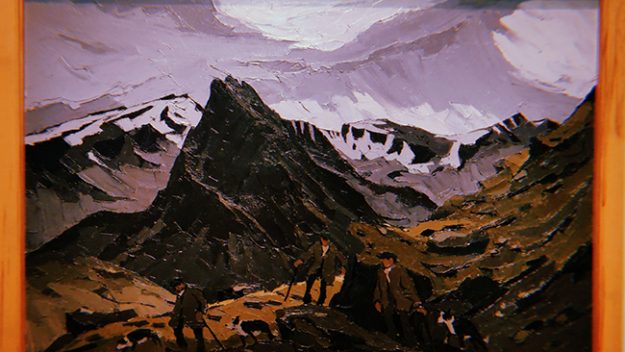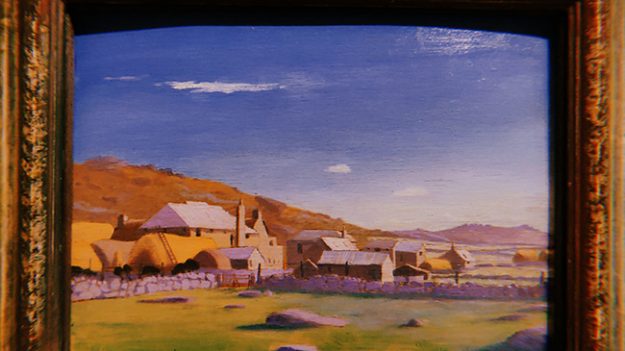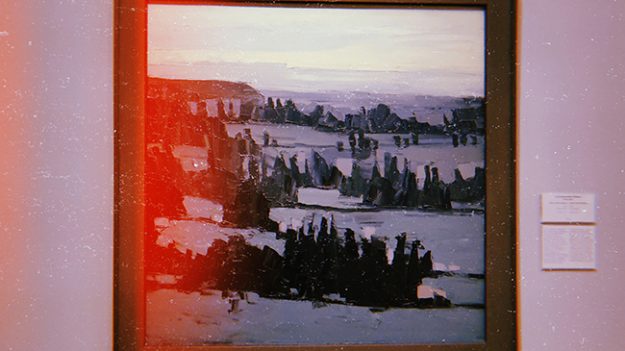Sir Kyffin Williams was one of the most influential painters in the history of Welsh landscape art, and his paintings provide a great insight into national art and culture.

The thick, bold swathes of olive-green and grey pigment on the mountains and the clouds are the most predominant features when you look at Farmers on the Carneddau. The strokes of the palette knife capture the emotions and depth of what the artist was thinking.
To celebrate Williams’ centenary, his artworks were displayed in Anglesey and Aberystwyth and now are in Cardiff at the National Museum till May 2019.
Roger Ellis, an artist in Ullingswick said, “I think you can see what he feels about the place, what he feels about the people and it comes through the painting. That is what personally, strikes me the most.”

Born in Llangefni, Anglesey, Williams was brought up in a household where his mother had a strong dislike of the Welsh language and culture. Throughout his childhood, he faced a lot of medical issues and difficulties in school, but soon enough, art became one of his key areas of interest.
Even though he did his college, university, and teaching in England, Wales never left his consciousness or imagination, which is why all his landscape paintings were inspired by places in Wales.
Over the years, he was said to be one of the most influential artists in Welsh history.
Sir Kyffin was renowned for his stark oil paintings of the North Wales landscape, as well as his portraits and drawings.

In an entry in his diary, written in 1993, the artist wrote: “It is ironic that I am the most loved and most honored Welsh artist of all time and yet I am hated by the art world.”
Williams was a harsh critic and had a long and interesting history with National Museum Wales, both his loyal supporter and fierce critic.
His engagement with the institution was sparked by a childhood encounter and continued through his work as an artist and service on museum’s advisory committees for much of his life. In addition to his own paintings, Williams also donated works by other artists to National Museum Wales’ collection and bequeathed yet more on his death.
A spokesman for the National Museum of Wales said it was “delighted to reveal plans to hold an extensive exhibition… to commemorate the 100th anniversary of the birth of one of the defining Welsh artists of the 20th Century.”

Melanie Hobday, museum assistant at National Museum Wales, Cardiff says, “National Museum Cardiff acquired its first Kyffin painting as early as 1947, and have continued to collect more throughout the artist’s life. Right now, we own over forty works by him, of which at least one element is on display in the permanent collection.”
Williams had a considerable sphere of influence in the cultural life of Wales.
He was firmly at the heart of ‘establishment’ debate, whether as a Royal Academician, President of the Royal Cambrian Academy or on National Museum Wales’ Art Advisory committee where he petitioned for a gallery dedicated to art in Wales up to 1950.

Ruth, an art critic and enthusiast, says, “I personally like his portraits more than landscape as landscape give out very dark vibe for me. His portraits so different from other artists because it does not look like a photograph, you can really see the emotions he was feeling while painting them.”
Williams was always famously critical of much contemporary art, though was a loyal supporter of selected artists he felt deserved a wider appreciation.
Ultimately, although he might have felt his opinion at odds with those of others, there is no doubt that Williams’ position gave him a considerable platform to express his feelings about the nature and presentation of the visual art in Wales.
The exhibition celebrating 100 years of birth of Williams will be around in Cardiff for a last couple of months until 1 May 2019 and it’s free. WIlliams is the epitome of the nation, and his work a definition of Welshness.
Why not get a glimpse of this invaluable piece of Welsh heritage next weekend?

(function (d) { var js, id = “genially-embed-js”, ref = d.getElementsByTagName(“script”)[0]; if (d.getElementById(id)) { return; } js = d.createElement(“script”); js.id = id; js.async = true; js.src = “https://view.genial.ly/static/embed/embed.js”; ref.parentNode.insertBefore(js, ref); }(document));
While you are there, why not pop in and check out the new Leonardo Da Vinci exhibition?
